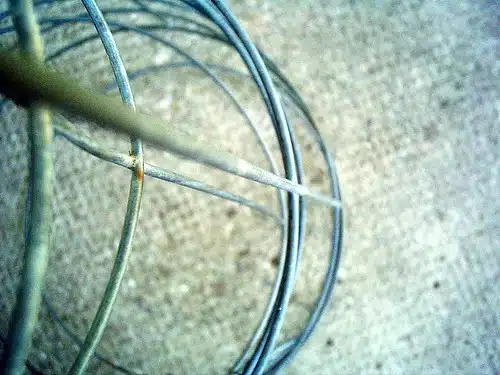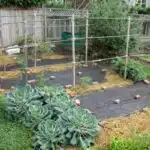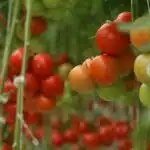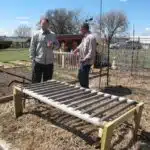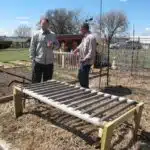Tomatoes are one of the most popular vegetable plants grown in home gardens. They are versatile, easy to grow, and produce a bountiful harvest. However, without proper support, they can become unruly and difficult to manage. That’s where tomato cages come in. In this article, we will discuss the benefits of using tomato cages and provide tips on how to use them effectively.
Tomato cages are essential for keeping your tomato plants upright and supported throughout the growing season. They provide stability for the plant stems and prevent them from breaking under the weight of heavy fruit. Tomato cages also help to improve air circulation around the plant, reducing the risk of disease and promoting healthy growth. With proper use, tomato cages can increase yields, make harvesting easier, and create a more attractive garden space. In this article, we will cover everything you need to know about selecting, installing, and maintaining tomato cages to get the best results from your tomato plants.
Benefits Of Using Tomato Cages
Tomato cages are a popular tool used by gardeners to support and maintain the growth of tomato plants. One of the primary benefits of using tomato cages is that they provide stability to the plant, preventing it from falling over due to its weight or external factors such as wind and rain. This stability allows for better air circulation, which reduces the risk of diseases and pests.
Another benefit of using tomato cages is that they promote healthy growth in the plant. By keeping the plant upright and providing support, tomato cages allow for more efficient use of nutrients and water. This can lead to stronger roots, healthier foliage, and ultimately higher yields come harvest time.
Maintenance is also made easier with the use of tomato cages. Gardeners can easily access their plants for pruning, picking, or any other necessary maintenance without disturbing the surrounding soil or damaging nearby plants. Additionally, using tomato cages can prevent fruit from rotting on the ground due to contact with soil or being stepped on by humans or animals.
Understanding your tomato plant’s needs is crucial in maintaining healthy growth and high yields. By utilizing tomato cages in your garden, you can provide your plants with the necessary support and stability they need while also making maintenance a breeze. Now let’s dive into understanding what your tomato plant specifically requires for optimal growth!
Understanding Your Tomato Plant’s Needs
- Tomatoes require adequate water to grow and produce fruit, so be sure to check the moisture level in the soil periodically.
- It is important to ensure that tomato plants are receiving adequate sunlight, so make sure they are planted in an area that gets at least six hours of sun per day.
- Nutrients are essential for tomato plants to develop and produce healthy fruits, so use a fertilizer that is specifically formulated for tomatoes.
- Tomato plants require soil with a pH balance between 6.0 and 6.8, and that is loose and has good drainage.
- Pruning and spacing tomato plants properly helps to ensure that they receive proper air circulation and adequate light.
- Staking or using tomato cages is recommended to help support the plant, keep fruit off the ground, and protect from pests and diseases.
Water
Tomato plants require adequate watering to thrive, and understanding their watering needs is crucial for optimal growth. Watering frequency depends on several factors, including the size of the plant, weather conditions, and soil moisture levels. In general, tomato plants require consistent moisture throughout the growing season to prevent stress and promote healthy growth.
To determine the appropriate watering frequency for your tomato plants, it is essential to monitor soil moisture levels regularly. Stick your finger about an inch deep into the soil around the plant’s base to assess its moisture content. If the soil feels dry at this depth, it is time to water your plant. On average, tomato plants need about one inch of water per week during moderate weather conditions. However, during hot summers or extended dry spells, they may require more frequent watering.
Overwatering can be just as detrimental as underwatering for tomato plants. Excess water can lead to root rot and other diseases that stunt plant growth or even cause it to die off entirely. Therefore, it is vital to strike a balance between providing enough water without over-saturating the soil. By monitoring your tomatoes’ soil moisture levels and adjusting your watering frequency as needed, you can help ensure that your plants stay healthy and produce a bountiful harvest.
Sun
Sun exposure is another crucial factor that affects the growth and development of tomato plants. They require at least six hours of direct sunlight each day to thrive. Insufficient sun exposure can lead to stunted growth, poor fruit production, and increased susceptibility to pests and diseases. Therefore, it is essential to choose a location for your tomato plant that receives ample sunlight throughout the day.
When planting your tomato plant, consider the soil moisture levels in the chosen location. The soil should be well-drained and moist but not waterlogged. Overly wet soil can prevent oxygen from reaching the roots, leading to root rot and other fungal diseases. It is advisable to amend the soil with organic matter such as compost or manure to improve its drainage and moisture retention capabilities.
While adequate watering is crucial for optimal growth, providing too much water or exposing your tomato plants to excessive sun can have adverse effects on their health. Therefore, it is essential to strike a balance between sun exposure, soil moisture levels, and watering frequency when growing tomatoes. By monitoring these factors regularly and adjusting them as needed, you can help ensure that your plants stay healthy and produce a bountiful harvest.
Nutrients
To ensure that your tomato plants grow and produce a bountiful harvest, it is essential to understand their nutrient requirements. Fertilizer application plays a crucial role in providing the necessary nutrients for healthy plant growth. Nitrogen, phosphorus, and potassium are the primary macronutrients required by tomato plants. Nitrogen is essential for leafy green growth, while phosphorus aids in root development and fruit production. Potassium helps regulate water balance in the plant and enhances disease resistance.
Soil preparation is vital when it comes to supplying your tomato plants with adequate nutrients. It is recommended to add organic matter such as compost or aged manure to the soil before planting to improve soil structure and fertility. A well-draining soil with a pH level of 6-7 is ideal for growing tomatoes. Soil testing can help determine if your soil has any deficiencies or imbalances that may affect plant growth and fruit production.
When applying fertilizers, it is crucial to follow the recommended dosage rates as over-fertilization can lead to nutrient toxicity and poor plant growth. A balanced fertilizer with equal proportions of nitrogen, phosphorus, and potassium is suitable for most tomato varieties. Applying fertilizers every three weeks during the growing season can help ensure that your tomato plants receive adequate nutrition to produce healthy foliage and fruits.
Choosing The Right Type Of Tomato Cage
Just like how a chef chooses the right utensil for cooking, a gardener must also choose the right tomato cage that will support their plants. Tomato cages are an essential tool for any vegetable garden, as they keep the plant upright and prevent it from bending or breaking under the weight of ripening fruit. When selecting a tomato cage, gardeners should consider whether they need a sturdy or flexible option to best suit their needs.
Sturdy tomato cages are made from materials such as galvanized steel wire or concrete reinforcing mesh. These cages offer superior stability and strength, making them ideal for larger plants or heavy fruit loads. However, they can be more difficult to store and transport due to their rigid structure. On the other hand, flexible tomato cages made from materials such as plastic or soft wire offer greater versatility and ease of use. They can be easily bent and shaped to fit any plant size, but may not provide enough support for heavier fruit loads.
Pros and cons exist for different tomato cage materials. For example, metal cages are durable and long-lasting, but may rust over time if exposed to moisture. Plastic cages are lightweight and easy to clean, but may not withstand extreme temperatures or windy weather conditions. Gardeners should weigh these factors when selecting a tomato cage material that will best suit their specific needs.
Transitioning into the subsequent section about materials for tomato cages: Now that we have discussed the importance of choosing between sturdy vs. flexible tomato cages and weighed the pros and cons of different materials, let’s delve deeper into each type of material available for tomato cages on the market today.
Materials For Tomato Cages
When it comes to making tomato cages, there are a variety of materials that can be used. While traditional metal cages are readily available for purchase at gardening stores, many DIY enthusiasts prefer to create their own using eco-friendly alternatives. Some popular materials include bamboo sticks, wooden stakes, and even repurposed wire fencing.
Bamboo sticks are an excellent choice for those looking for an earth-friendly option. They are readily available and easy to work with, making them ideal for DIY tomato cage projects. Another eco-friendly option is wooden stakes, which can be easily purchased from hardware stores or found in nature. These can be cut to the desired size and shape, making them a versatile choice for any garden.
For those who prefer a more industrial look, repurposed wire fencing can be used to make sturdy tomato cages. This material is durable and long-lasting, ensuring that your plants will have ample support throughout the growing season. Plus, using repurposed materials helps reduce waste and promote sustainability in gardening practices.
When considering the materials for your DIY tomato cage project, keep in mind the size and shape of your plants. Each variety of tomato may require a different type of support structure based on its growth habits and fruit size. In the next section, we will discuss how to determine the appropriate size and shape of your tomato cages to ensure optimal growth and yield from your plants.
Size And Shape Of Your Tomato Cages
- When selecting a tomato cage, the size and shape are important considerations.
- It is recommended that tomato cages be tall enough to support the full height of a mature tomato plant, with some extra space at the top for additional growth.
- The cage should also be wide enough for the tomato plant to spread out without being constrained.
- A round shape is commonly used for tomato cages because of its stability and durability; however, other shapes are available such as squares and triangles.
Choosing The Right Size
When it comes to choosing the right tomato cage, selecting the appropriate height and thickness is crucial. The size and shape of your tomato cages will have a significant impact on the growth and productivity of your plants. It is important to consider these factors carefully before making a purchase.
Choosing the right height for your tomato cage is essential for supporting the growth of your plants. Typically, tomato cages range from three to six feet in height. For determinate varieties that grow to a predetermined height, a shorter cage will suffice. However, indeterminate varieties can grow tall and require a taller cage for proper support. Additionally, selecting appropriate thickness for your tomato cage is important as it determines the strength and durability of the support structure.
Selecting an appropriate thickness ensures that your tomato cage can withstand the weight of mature plants without collapsing or bending. A thicker wire gauge will provide stronger support while also lasting longer than thinner gauges. It is important to note that thicker wire gauges are more expensive but are worth investing in as they provide better structural support over time.
In conclusion, choosing the right size and shape of your tomato cages plays an important role in supporting healthy plant growth and productivity. Selecting appropriate height and thickness ensures optimal structural support for mature plants throughout their growing season. By considering these factors carefully when making a purchase, you can ensure that your tomatoes thrive with proper support from their cages.
Shape Of Tomato Cages
When it comes to selecting the appropriate tomato cages, size and shape are both important factors. While we have already discussed the importance of choosing the right height and thickness, the shape of your tomato cages is equally crucial. The different types of tomato cages available on the market include cylindrical, square, and triangular shapes, each with their own unique benefits.
Cylindrical tomato cages are the most common type available and are popular due to their versatility. They can easily be used for a wide range of plants other than tomatoes such as peppers or eggplants. However, they tend to be less durable than other shapes due to their rounded edges. Square-shaped tomato cages, on the other hand, provide better structural support and stability for larger plants that require more upright growth.
Triangular-shaped tomato cages offer a unique design that maximizes space usage while still providing enough support for your plants. They are also more durable than cylindrical-shaped cages since they have stronger corners that prevent bending or collapsing under pressure. Ultimately, when choosing the shape of your tomato cage, it’s essential to consider durability and strength alongside its ability to provide adequate support for your plants’ growth throughout their growing season.
Installing Tomato Cages In Your Garden
The size and shape of your tomato cages are important factors to consider when growing healthy tomato plants. However, it is also crucial to know how to use them properly. Tomato cages offer numerous benefits, such as providing support for the plants, increasing air circulation, and preventing fruit from touching the ground. Proper use of tomato cages can help improve plant health, yield, and quality.
Different types of stakes can be used to support tomato plants, including metal stakes, wooden stakes, bamboo poles, and plastic stakes. Each type has its advantages and disadvantages. Metal stakes are durable but can be expensive. Wooden stakes are affordable but can rot over time. Bamboo poles are eco-friendly but may not be strong enough to support heavier plants. Plastic stakes are lightweight but may not be sturdy enough for larger plants.
To properly install tomato cages in your garden, follow these steps:
- Choose a location with well-draining soil that receives at least 6 hours of sun per day.
- Dig a hole deep enough for the base of the cage to anchor firmly into the ground.
- Place the cage over the plant and carefully adjust any branches or foliage that may have gotten caught in between the wires or supports.
Proper placement of tomato cages is essential for optimal plant growth and development. By ensuring that your tomatoes have adequate support and proper airflow through the cage’s openings, you can promote healthy growth while reducing pest damage and disease risks. With these simple tips in mind, you’ll be able to set up your tomato cages successfully and enjoy a bountiful harvest come summertime.
Proper Placement Of Tomato Cages
When using tomato cages for your vegetable garden, it is important to determine the proper spacing between each cage. The recommended distance between cages is three to four feet apart. This allows each plant to receive adequate sunlight and airflow, which helps promote healthy growth and prevent disease and pests from affecting your plants.
Another crucial factor in the placement of tomato cages is the quality of the soil. Before planting your tomatoes, ensure that the soil is well-drained and has proper nutrients for healthy growth. This includes the addition of compost or fertilizer to improve soil quality. Additionally, consistent watering of tomato plants is essential for their growth and productivity. Be sure to water them deeply once a week during dry periods.
Once your tomatoes have matured and are ready for harvesting, it is important to have easy access to each plant without damaging surrounding foliage or fruit. Properly spaced tomato cages will allow you to easily reach each plant and harvest ripe tomatoes without disturbing other fruits on nearby plants.
Transition: With proper placement of your tomato cages in mind, the next step is securing them firmly into place on the ground.
Securing Tomato Cages To The Ground
- Tomato cages are an effective way to help a gardener support the growth of tomato plants.
- The stakes used for the tomato cages should be sturdy and at least 18-24 inches long.
- Pounding the stakes into the ground is necessary to ensure the cages are securely held in place.
- A rubber mallet or a hammer should be used to pound the stakes into the ground.
- The tomato cages should also be anchored with stakes, cords, or wires to prevent them from tipping over.
- Anchoring the cages in multiple places will provide additional stability and support.
Choosing Stakes
Choosing the right stakes for securing tomato cages to the ground is a crucial step in ensuring that your plants grow strong and healthy. When choosing materials, it is important to consider durability and strength. Bamboo stakes are a popular choice due to their affordability and natural resistance to rot. However, metal or fiberglass stakes may be more suitable if you live in an area with harsh weather conditions.
Comparing sizes of stakes is also important as it directly affects the stability of your tomato cages. The size of your tomato plant should determine the height of the stake you choose. For smaller plants, shorter stakes will suffice, but taller plants require longer stakes for added support. Additionally, thicker stakes provide more stability when compared to thinner ones.
In conclusion, selecting the appropriate stake material and size is crucial in securing tomato cages to the ground. By taking into account durability, strength, and sizing requirements based on plant height, gardeners can ensure that their plants remain stable throughout their growth cycle. This not only serves our subconscious desire for serving others by producing healthy vegetables but also helps us avoid any potential damage caused by unstable cages during harsh weather conditions.
Pounding Stakes
Securing tomato cages to the ground is one of the essential practices that gardeners have to perform to ensure their plants’ stability and growth. One of the popular methods for securing tomato cages is by hammering stakes into the soil. Hammering stakes is a crucial step in ensuring that your tomato cages remain stable throughout the growth cycle. However, gardeners should be careful when hammering stakes to prevent damaging their plants.
When pounding stakes, it is important to avoid hitting the plant’s roots, which may cause damage or even death to your tomatoes. To avoid this, gardeners should pound stakes at least six inches away from their plant’s stem. In addition, they should use a mallet instead of a hammer as it provides better control and reduces the risk of damaging plants.
While pounding stakes remains a popular option for securing tomato cages, there are alternative support options available for gardeners who want to avoid using this method. Using concrete reinforcement wire or PVC pipes can provide additional support for your tomato cages without risking any damage to your plants’ roots. These alternatives give you more control over where you place them and how much support they provide, making them a great option for those new to gardening or those who prefer non-intrusive support systems.
Anchoring Cages
In addition to pounding stakes, anchoring cages is another effective method for securing tomato cages to the ground. Choosing materials for anchoring cages will depend on various factors, including the size and weight of your tomato cage, the type of soil in your garden bed, and your budget. Some popular options include sandbags, cinder blocks, or even decorative rocks.
Benefits of anchoring cages include providing additional stability to your tomato plants during strong winds or heavy rainfall. Moreover, anchored cages can prevent them from toppling over and damaging other plants in your garden bed. Additionally, it can prolong the life of your tomato cage by reducing wear and tear caused by constant movement due to weather conditions.
Overall, choosing between pounding stakes and anchoring cages will depend on your gardening needs and personal preferences. Both methods have their own unique advantages and disadvantages that should be considered before making a decision. Regardless of which method you choose, ensuring that your tomato cages are secure will result in healthier plants and a bountiful harvest.
Maintaining Your Tomato Cages
After securing your tomato cages to the ground, it is important to properly maintain them throughout the growing season. One crucial aspect of this maintenance is cleaning the cages. As plants grow and produce fruit, they can leave behind debris and residue on the cages. This buildup can lead to disease and pest problems if left unaddressed. To prevent this, regularly inspect your tomato cages and use a soft-bristled brush or cloth to gently remove any buildup.
Once you have finished using your tomato cages for the season, it is important to store them properly to ensure their longevity. Start by cleaning off any remaining debris or residue from use with soap and water. Allow them to dry completely before storing them in a cool, dry place such as a garage or shed. It is also recommended to stack them neatly together for easier storage.
Properly maintaining and storing your tomato cages will not only prolong their life but also ensure that they are ready for use when you need them again next season. In addition, as your plants grow taller, it may be necessary to adjust the height of the cages accordingly. This can be done by adding additional stakes or extending the cage arms upwards. Regularly checking on and adjusting your tomato cages as needed will help keep your plants healthy and productive all season long.
Adjusting Tomato Cages As Your Plants Grow
- When selecting a tomato cage, it is important to pick a size that accommodates the plant’s current size and potential growth.
- As the tomato plant grows, its cage should be repositioned to provide adequate support.
- Tomato cages should be securely anchored in the ground to ensure the plant is stably supported.
- When placing a tomato cage around a plant, it is important to make sure the cage is not too tight to avoid damaging the stem.
- If additional support is required, stakes can be placed near the cage for extra stability.
- When adjusting or replacing the tomato cage, it is best to do so when the plant is dry to minimize damage to the foliage.
Picking The Right Size Cage
Choosing appropriate tomato cages is crucial in ensuring the healthy growth of your tomato plants. The right size of a tomato cage will provide the necessary support for your plants to grow and bear fruit. When selecting a cage, consider its durability and sturdiness. Flimsy cages may not be able to withstand the weight of ripe tomatoes, causing them to topple over and damage the plant.
Tomato cage alternatives are also available for those who prefer not to use traditional metal cages. Some gardeners use stakes or trellises as an alternative to cages. Stakes can be driven into the ground next to your tomato plant, providing support as it grows taller. Trellises, on the other hand, allow for vertical growth and can accommodate multiple plants in a small space. However, each option has its pros and cons that should be considered before making a decision.
In summary, choosing the right size and type of tomato cage is essential in supporting healthy tomato plants. Be sure to select durable and sturdy cages that can withstand the weight of ripe tomatoes without damaging the plant. Alternatively, explore other options such as stakes or trellises that may better suit your gardening needs.
Re-Positioning The Cage
Adjusting tomato cages as your plants grow is an important aspect of tomato plant care. As your tomato plants grow taller and wider, they may outgrow their original cage placement, making it necessary to re-position the cage. Knowing how to re-position tomato cages can help ensure that your plants receive the support they need to continue growing and producing fruit.
To re-position a tomato cage, start by loosening the soil around the base of the plant with a garden fork or shovel. Carefully lift the plant and gently move it to one side, being careful not to damage the stem or roots. Then, slide the cage over to its new location, positioning it as close to the plant as possible while still allowing room for growth. Finally, carefully lower the plant back into place and use garden ties or clips to secure it to the cage.
Tips for maintaining tomato cages include regularly checking on them throughout the growing season and making adjustments as needed. This may involve adding additional supports or re-positioning the cage again if necessary. It is also important to prune your tomato plants regularly to prevent overcrowding and ensure proper air circulation around each plant. By following these tips, you can help ensure that your tomato plants stay healthy and productive throughout the growing season.
Supporting The Plant With Stakes
As tomato plants grow taller and wider, they may outgrow their original cage placement, making it necessary to re-position the cage. In addition to re-positioning the cage, supporting the plant with stakes is another method of providing additional support. Supporting tomato plants with stakes can be an effective alternative to cages, particularly for determinate varieties that don’t require as much vertical support.
One benefit of using stakes is that they allow for greater air circulation around each plant, which can help prevent diseases such as blight. Stakes also make it easier to prune tomato plants by allowing you to easily access each stem. Pruning is an important aspect of tomato plant care as it helps prevent overcrowding and ensures proper air circulation around each plant. This can be done by removing any suckers or side shoots that appear between the main stem and branches.
When using stakes, it’s important to choose sturdy materials such as bamboo or wooden dowels that are at least 6 feet tall. Drive the stake into the ground about 6 inches away from the base of the plant and tie the stem loosely to the stake in several places along its length using garden ties or clips. As your tomato plants grow taller, use additional ties to secure them to the stake and gently adjust their position if necessary. By regularly checking on your tomato plants throughout the growing season and making adjustments as needed, you can help ensure a healthy harvest of delicious tomatoes.
Pruning Your Tomato Plants For Optimal Growth
Metaphorically speaking, pruning is like giving your tomato plants a haircut. Just as we trim our hair to promote healthier growth and prevent split ends, pruning helps to stimulate new growth in tomato plants while also preventing overcrowding and disease. Pruning techniques involve removing the suckers (small shoots that grow between the main stem and branches) and any diseased or damaged leaves. Timing for pruning can vary depending on the type of tomato plant and growing conditions, but it is generally recommended to start pruning once the first few clusters of flowers have bloomed.
When it comes to pruning your tomato plants, there are a few key things to keep in mind. First, make sure you have sharp, clean shears or scissors to avoid damaging the plant. Second, be strategic in which suckers you remove – aim for those that are smaller in size and located closer to the base of the plant. Third, don’t go overboard with pruning – removing too many leaves can actually hinder growth and lead to sunscald (damage caused by too much direct sunlight).
In addition to promoting healthier growth, proper pruning can also lead to larger fruit yields and better taste overall. By removing excess foliage, more energy is directed towards developing larger fruits rather than supporting unnecessary foliage growth. Additionally, increased air circulation from proper pruning can help reduce moisture buildup on leaves which can lead to fungal diseases. Remember that timing is key when it comes to pruning – start early enough so as not to damage new growth but late enough so that the plant has had time to establish itself.
To further encourage healthy growth of your tomato plants trained on cages:
- Choose sturdy cages made from materials such as galvanized steel or concrete reinforcement wire.
- Ensure adequate spacing between each cage (at least 2 feet apart) for optimal air circulation.
- Tie stems loosely but securely to cages using soft ties made from materials such as twine or cloth.
- Water plants deeply and regularly, aiming to keep soil consistently moist but not waterlogged.
- Use fertilizer sparingly and only after plants have been established for several weeks.
Training Your Tomato Plants To Grow On Cages
Tomato cages are a popular way to support tomato plants as they grow tall and heavy with fruit. However, simply placing the cage around the plant is not enough. To ensure maximum growth and yield, it is important to train the tomato plant to grow on the cage properly. This involves gently guiding the stems through the cage as they grow and pruning them as needed.
To begin training your tomato plant, start by placing the cage firmly in the ground near the base of the plant. As the plant grows taller, use your hands to gently guide each stem through one of the openings in the cage. Be sure to space out each stem evenly around the perimeter of the cage so that they have room to grow without overcrowding each other.
If you don’t have access to tomato cages or prefer not to use them, there are alternative methods for supporting your plants. DIY tomato cages can be made from materials such as bamboo stakes or PVC pipes, or you can use trellises or even old garden fencing. The key is to provide sturdy support that will keep your plants upright and prevent them from flopping over under their own weight.
Common Issues With Tomato Cages And How To Fix Them
Collapsing cages are a common issue when using tomato cages. A heavier gauge of wire, such as 16-gauge, can help to prevent the cages from collapsing due to the weight of the tomatoes. Rusting cages can be avoided by selecting a metal cage made of galvanized steel which is resistant to rust. For those with too-small cages, taller cages can be used for indeterminate tomato varieties which can grow up to 8 feet in height. Additionally, the cages can be reinforced with stakes to provide extra support for the plants. Pruning the tomato plants can also help to reduce the amount of weight on the cages. Finally, rotating the cages throughout the season can help to evenly distribute the weight.
Collapsing Cages
Tomato cages are an essential tool for any gardener looking to cultivate a healthy crop of tomatoes. However, one common issue with these cages is their tendency to collapse under the weight of the growing plant, which can lead to damage or even death. To prevent this from happening, it is important to take steps to reinforce the structure of your tomato cages.
One effective method for preventing collapse is to use thicker gauge wire when constructing your cages. This will provide greater stability and support for the growing plant, reducing the risk of collapse. Additionally, you may want to consider using multiple smaller cages rather than one large one, as this can help distribute the weight of the plant more evenly and reduce stress on any one area.
Another way to reinforce your tomato cages is by adding additional supports or stakes around the perimeter of the cage. This can be done by inserting wooden or metal stakes into the ground around the base of the cage and then tying them together with twine or wire. By providing additional support from all sides, you can help ensure that your tomato plants remain upright and healthy throughout their growth cycle.
Rusty Cages
Tomato cages are a crucial tool for any gardener who wishes to cultivate healthy tomato plants. However, over time, these cages may develop rust, which can compromise their structural integrity and lead to the collapse of the plant. Rust is a common issue with tomato cages that can be easily fixed by removing rust buildup regularly and taking measures to prevent it from forming in the first place.
To remove rust from tomato cages, start by cleaning them thoroughly using soap and water. Once they are dry, use a wire brush or sandpaper to scrape off any remaining rust buildup. If the rust is particularly stubborn, soak the cage in vinegar or lemon juice for several hours before scrubbing it again. After removing all traces of rust, apply a coat of rust-resistant paint or primer to help prevent future corrosion.
Preventing rust buildup on tomato cages involves keeping them dry and avoiding exposure to moisture as much as possible. This can be achieved by storing them in a dry location when not in use and covering them during periods of rain or high humidity. Additionally, you may want to consider treating your cages with a rust inhibitor spray or oil-based lubricant to help repel moisture and protect them from corrosion.
In conclusion, dealing with rusty tomato cages is an important aspect of maintaining healthy tomato plants. By removing existing rust buildup and preventing it from forming in the first place, gardeners can ensure that their tomato cages remain sturdy and reliable throughout the growing season. Taking steps to care for your tomato cages will pay off in the long run by helping you produce healthy and bountiful crops year after year.
Too-Small Cages
Another common issue with tomato cages is that they may be too small for the plant’s growth, leading to overcrowding and limited air circulation. This can result in stunted growth, disease, and reduced yield. Gardeners may encounter this problem if they use pre-made cages or repurpose other types of wire cages not specifically designed for tomatoes.
One solution to this problem is to use DIY alternatives such as stakes or trellises made from sturdy materials like wood or PVC pipes. These can be customized to fit the size and shape of the tomato plants and provide adequate support as they grow taller. Alternatively, gardeners can purchase cage extensions that can be attached to existing cages, allowing for additional height and space for the plants.
When selecting a cage extension or building a DIY alternative, it is important to ensure that it is strong enough to support the weight of the tomato plant and its fruit. The structure should also allow for good air circulation and easy access for pruning and harvesting. With proper care and attention, gardeners can address the issue of too-small cages while promoting healthy growth and optimal yield from their tomato plants.
Alternative Support Options For Tomato Plants
After addressing the common issues with tomato cages, it’s important to consider alternative support options for your tomato plants. While traditional tomato cages may work for some gardeners, there are DIY tomato cage options that can be more cost-effective and customizable to fit specific plant needs. For instance, using sturdy wooden stakes and twine to create a trellis-like structure can provide ample support for your plants while also allowing for vertical gardening techniques.
Vertical gardening techniques not only save space but also maximize sunlight exposure and air circulation around the plant foliage. This can lead to healthier plants and higher yields of ripe tomatoes. Additionally, using a trellis or other vertical support system allows for easier maintenance tasks such as pruning, harvesting, and pest control.
In summary, when it comes to supporting your tomato plants, traditional cages are just one option. By exploring alternative methods like DIY tomato cages and vertical gardening techniques, you can create a more efficient and effective system that maximizes your tomato yields. Don’t be afraid to get creative and experiment with different support structures – your plants will thank you!
Maximizing Your Tomato Yields With Tomato Cages
Tomato cages are essential for tomato plant growth and yield maximization. They provide support for the plants, keeping them upright and preventing them from falling over or breaking under the weight of their fruit. Traditional tomato cages are made from metal wire and come in various sizes to accommodate different types of tomatoes, including cherry, grape, and beefsteak.
However, there are alternatives to traditional tomato cages that can be just as effective. For example, some gardeners use stakes or trellises instead of cages to keep their plants off the ground. Stakes can be made from wood or bamboo and driven into the ground next to each plant for support. Trellises are also a great option for those who have limited space in their garden as they allow you to grow your tomatoes vertically.
If you prefer a more DIY approach to your tomato cage setup, there are many options available online with easy-to-follow instructions. Some popular DIY tomato cage ideas include using PVC pipes or chicken wire to create custom-sized cages that fit your specific needs. By making your own tomato cages, you can save money and customize them to suit your individual gardening style.
Incorporating tomato cages into your gardening routine is crucial for maximizing yields and ensuring healthy plant growth. Whether you choose traditional metal wire cages or opt for alternative methods like stakes or trellises, investing in proper support for your plants will pay off in the long run. With so many options available including DIY alternatives, it’s easy to find the perfect solution that will work best for you and your garden needs.
Conclusion
Tomato cages are a must-have for any seasoned gardener or novice enthusiast. Not only do they provide support for your tomato plants, but they also help to prevent diseases and pests from attacking your crops. By understanding your tomato plant’s needs and choosing the right type of cage, you can maximize the yields of your harvest and enjoy a bountiful supply of fresh, juicy tomatoes.
One cannot overemphasize the importance of using tomato cages in your garden. The benefits are simply too numerous to ignore. Without proper support, tomato plants may fall over or become entangled with neighboring plants, leading to reduced sunlight exposure and poor air circulation. This can cause a host of problems such as fungal diseases and insect infestations that will ultimately reduce yields. Therefore, investing in high-quality tomato cages is essential if you want to achieve optimal results in your garden. So, get ready to experience the joys of plucking ripe tomatoes straight from the vine with these handy tips on how to use tomato cages!
Image Credits
- “Tomato Cages” by Kim Siever (featured)

